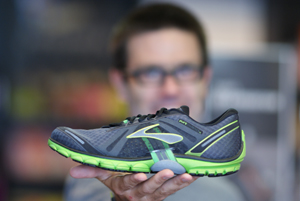Knowing your foot type and the biomechanics that take place during running can be of great value when attempting to select the right running shoe. A great shoe for one runner may be completely wrong for another. If we all had the same feet and they functioned the same, we would all choose the same shoe.
By now, most runners are familiar with the three various foot types: the flat foot, where overpronation usually takes place; the normal foot type, where a normal amount of pronation occurs; and the high arched foot, where the foot under pronates.
Most runners can determine if they pronate sufficiently by examining their arch height. Another way to test is to wet the foot, stand on a dry surface, and evaluate the footprint that is created. The flat or low arched foot will show a greater surface volume, and its print will show a complete arch. The normal arch will effect a mild scooped-out arch area, whereas the high arched foot will demonstrate a hollowed out arch, barely to the opposite side.
What exactly does pronation mean? After the heel lands on the ground (heel strike), usually to the outside, the foot then rolls inward slightly to a neutral position, making full contact with the ground. This is the mid-stance phase of running gait. Now comes the time for pronation: as the foot begins to roll inwards and downward, it begins to pronate. Now, this is a vital motion for the foot due to the fact that it provides for propulsion and impacts shock absorption.
Continue Reading »

